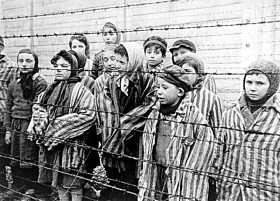
Surviving children in the main concentration camp, Auschwitz. This still from documentary footage shot by Alexander Voronzow shows Tomasz Szwarz, Alicja Gruenbaum, Solomon Rozalin, Gita Sztrauss, Wiera Sadler, Marta Wiess, Boro Eksztein, Josef Rozenwaser, Rafael Szlezinger, Gabriel Nejman, Gugiel Appelbaum, Mark Berkowitz, Pesa Balter, Rut Muszkies, Miriam Friedman, and Miriam and Eva Mozes. Licensed for the public domain by the United States Holocaust Memorial Museum.
Seventy years ago to this day, the Soviet Army liberated the death camps Auschwitz I and II. Almost ten years ago, the anniversary was designated International Holocaust Remembrance Day. Although I’ve been reflecting on representations of the Holocaust in art, literature, and philosophy for many years, I remain irritatingly little affected by today’s date, January 27. In most European countries, official events will once again collectively recall that breach of civilization and commemorate those who were systematically murdered. So too will Germany. Here, the decision to officially commemorate the victims of the Holocaust on this day was reached in 1996—not least because → continue reading
Interview with Alexis Hyman Wolff

Alexis Hyman Wolff in her exhibition Zur Zeit at the Museum der Dinge, Berlin, June 2013.
Photo courtesy of the artist.
One of the works in our art vending machine is a candle shaped like a root, made by the artist and curator Alexis Hyman Wolff. In this interview, she offers insight into the development of the work:
Christiane Bauer: Why did you make a candle for the art vending machine?
Alexis Hyman Wolff: Thinking about the small size of the objects and the temporary home they would find in the vending machine, I wanted to reflect on the idea of the souvenir, a central theme in museums. Candles are used for memorial in many cultures. In Jewish tradition, a yortsayt candle is lit to remember a loved one on the anniversary of their death.
What is special about the material you used?
The candles are made out of beeswax from a beekeeping supplier in Berlin. I understand that beeswax is one of the few materials that burn without producing black smoke, which could explain the belief that burning beeswax candles is good for the air. According to a European folk custom, when someone dies, a member of the family must go to the hive and “tell the bees,” and also invite them to the funeral. This tradition suggests a link between bees and the spirit world.
How important is the aspect of “remembrance” in your work? → continue reading

